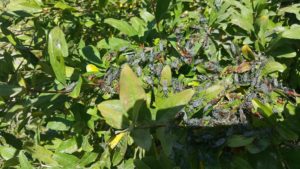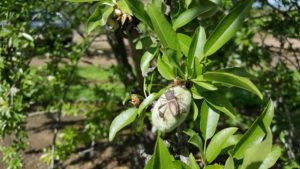Written by Kris Tollerup, University of California Cooperative Extension Area-wide IPM Advisor, Kearney Agricultural Research and Extension Center, Parlier, CA

For a few seasons now, I have been interested in understanding more and ultimately finding better monitoring tools for Leaffooted bug, Leptoglossus spp. Most growers and PCAs have a good working knowledge of this bug and likely have attended one or more of my talks covering the subject. We know that leaffooted bug overwinters in aggregations consisting of just a few to several hundred individuals. The aggregations tend to occur on citrus, palm frowns, Cyprus trees, pomegranate, walnut (Fig. 1), olive, and on/in non-plant substrates like pump houses, farm equipment, and wood piles. The list is extensive. The reason why aggregations can occur on such a diversity of substrates is that they are not necessary interested in feeding but more so in seeking a protected area to survive winter. An interesting behavior that I have made is that aggregations typically occur where the group can best collect heat from the sun during peak solar radiation periods.
In spring or as early as late winter, individuals begin leaving aggregations. I, as well as other researchers, found that dispersion is closely associated with temperature and not necessarily dependent on other environmental factors such as day length. I observed some moderately large aggregations on pomegranate in Tulare Co. and after warm mid-February temperatures of about 80 F, nearly all the LFB dispersed. To particularly where, at that early time in the season, we did not determine. The site had neighboring plantings of citrus and olive, which we surveyed but did not observe LFB in those crops. Typically at mid-March, LFB starts moving into almond and history shows that they can cause substantial economic damage.
Because of work conducted by a host of researchers including, Kent Daane, Kris Tollerup, Brad Higbee, and David Haviland, we have a good understanding of how to manage LFB with insecticides once detected in an orchard (see UC IPM Guidelines for LFB on almond and pistachio). We do not, however have a tool to monitor LFB early in the season when they first begin moving into almond. A handful of University of California and USDA-ARS researchers, including myself are looking at possible lures that could serve to attract LFB to a monitoring trap.

Over the past few years, my team has been working to develop a lure comprised of whole-ground-almond (WGA). We have determined that adult and immature LFB will aggregate on navel orangeworm (NOW) egg traps baited with whole-ground almond. To increase the effectiveness, we modified the NOW egg trap by attaching a 9.75-inch wooden shish kabob skewer to the side which provides a branch-like substrate for LFB egg-laying. The hypothesis is that females will detect a suitable food-source lure and subsequently lay eggs on the trap. Such a trap could detect the early-season movement of LFB into almond via egg-laying.
The UC Pest Management Guidelines recommends monitoring for LFB in almond during March and April by examining aborted nuts for gummosis, or oozing on the nut surface. An important note is that if gummosis is found, it should be distinguished from a physiological disorder by cutting a cross section through the nut and looking for a puncture wound. The drawback, however is that considerable damage can occur before detecting the bug. Additional sampling methods that can be used in April and May include using a beat tray for mid-canopy sampling or a long pole to knock upper-canopy branches to startle adults, causing them to fly. Beat trays provide a useful tool for detecting nymphs but it indicates that adults have been present long enough to lay eggs and for the eggs to hatch. In other words, feeding damage has likely already occurred.
The most effective monitoring method is to be creative. Start by looking for overwintering aggregations around orchards, paying close attention to the proximity of any pomegranate orchards and / or pomegranate hedgerows. If you locate aggregations, note their size and watch them weekly starting at the end of February or early-March to estimate when they begin to disperse. Monitor orchard edges, especially those close to known or possible overwintering sites. Search the sunny side of tree canopies for about 15 to 20 seconds per tree for adult LFB on developed nuts.
Insecticide use should occur only if monitoring indicates the presence of leaffooted bug and/or its feeding damage. Apply insecticides only after considering the potential risks of the compound to beneficial organisms, including bees and biological control agents, and to air or water quality. For more information on these topics please consult the UC IPM Pest Management Guidelines for Almonds.


Thomas Zavesky
February 6, 2017I have found scouting almonds from early March, and for the first two hours after sunrise, I can find LFB on a leaf or nutlet, sunning themselves while its still cool.
David Doll
February 6, 2017Thomas,
Thanks for sharing. I am hoping we will be able to get a better handle on this in the future. Please keep us updated if you see any aggregations or begin seeing the bugs int he spring. Feel free to email Kris at ketollerup@ucanr.edu
David
Jim Lowrey
February 7, 2017So, I have seen aggregation of LFPB adults overwintering in and on un-harvested pomegranates. Usually they appear in cracked fruit and congregate in the interior of the fruit. I have also seen them as individuals and copulating adults on green apricot fruit in an adjacent field to almonds in early March February 2016. I would assume that after they move out of the overwintering site(s) with increases in temperature.
The question I have is when is the best time to control them in almonds and what is the best recommendation for control. I did a search on Agrian and Belay (clothianidin) came up pomegranates and almonds. I have used Belay before with excellent results in grapes for other insect species. Would Belay be the best option for control?
Lori
March 6, 2017Why not destroy the aggregations when found, while they are dormant and overwintering, before the migration into crops begins? It seems they could easily be sprayed or even collected by hand from the overwintering sites and destroyed? Do they have any known ecological benefit?
Kris Tollerup
March 7, 2017Good point, I worked on the question last year and will work on it again this year. My data from 2016/2017 suggest that the best time to spray overwintering populations is during October and November on pomegranate. Pyrethroids are not registered on pomegranate but there was a Section 18 for Brigade (Lamda Cyholthrin) that expired on 31 Dec 2016. Belay may be an effective alternative to Brigade. It is a reduced-risk category insecticide and has excellent contact but no residual activity against LFB. In other words, if you can get the insecticide on the bugs it will likely kill them. Growers and PCAs have reported excellent results using Belay.
It’s too late to do much about the overwintering LFB now; they are beginning to move and the aggregations moved out of pomegranate back in January. To manage LFB at this stage in the season, start monitoring almond in the next few weeks, especially if we get some warm weather. Visually inspect the sunny side of tree canopies at the orchard edges; most notably edges near citrus, olive, and pomegranate; and possible overwintering sites such as Cyprus and juniper trees.